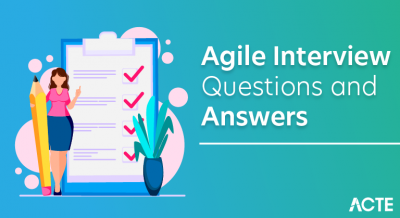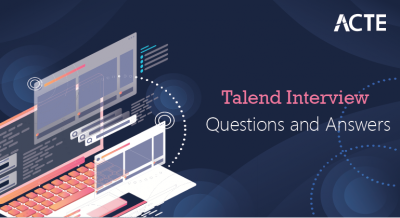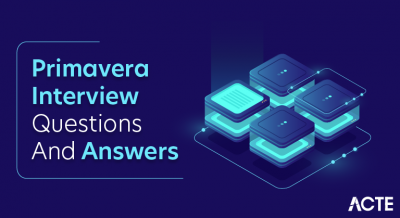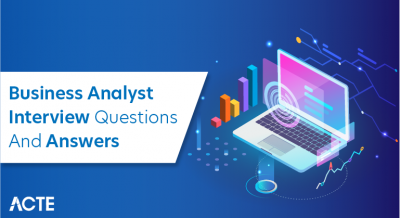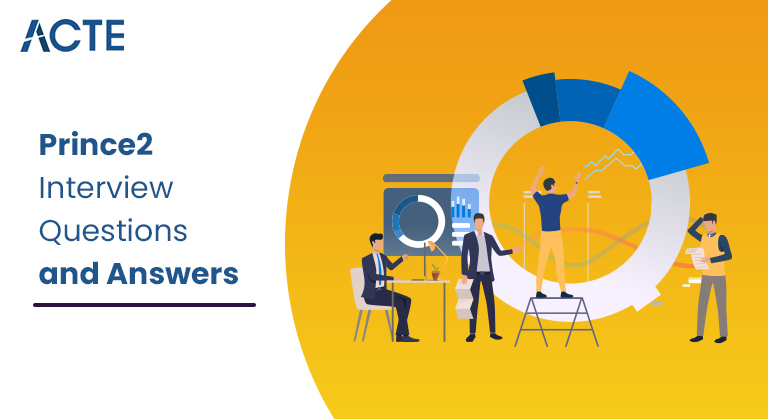
In today’s market, landing onto a quality job is quite a challenging task, especially if you are at the intermediate level of your career. In such times having professional certification such as PRINCE2® definitely comes in handy and will give you an edge over the non-certification holders. PRINCE2® Certification acts as proof of your skills, knowledge, and confidence to manage any complex projects successfully. But having the certification alone is not sufficient. You need to stay prepared for the interview and clear it as well.
1. What is Prince2?
Ans:
Prince2 stands for a project in controlled environment. It is the process based method which is used for an effective project management.
2. Define Project?
Ans:
In PRINCE2 a project is defined as the temporary organization that is created to deliver a one or more business products according to an agreed Business Case. The concept of the project in PRINCE2 aligns with the broader understanding of a project in a project management, emphasizing its temporary nature and the need to achieve specific objectives within a defined constraints
3. What are key features of prince 2?
Ans:
- Widely organized and understood
- Can be applied to the any project
- Based on the management by exception
- Invaluable diagnostic tool
- Consistency and reusability in a project work.
4. Define Plan?
Ans:
A plan defines the:
- Risks, Resources , Communication
- Scope, Budget, Schedule, Quality
5. What are levels of plan?
Ans:
- Project Plan
- Stage Plan
- Team Plan
- Exception Plan
6. What are planning steps?
Ans:
- Designing a pal
- Define products
- Identify the Activities and Dependencies
- Prepare Estimates
- Prepare Schedule
- Document plan
- Identify the Risks
7. What is process model of prince2?
Ans:
- Directing the project(DP)
- Starting up project(SU)
- Initiating project(IP)
- Controlling the stage(CS)
- Managing project delivery(MP)
- Managing stage Boundary(SB)
- Closing the Project(CP)
8. What is directing a project (DP)?
Ans:
- Support project
- Accept Results
- Provides the Management Approval
9. Explain Risk Response Plan in PRINCE2, and when is it developed?
Ans:
The Risk Response Plan in the PRINCE2 outlines how identified risks will be treated and managed. It is developed during “Initiating a Project” process and includes strategies for a mitigating, avoiding, transferring, or accepting risks.
10. What is Project Support Office (PSO) in PRINCE2?
Ans:
The Project Support Office (PSO) provides an administrative support to a Project Manager and assists in maintaining project controls and documentation. It contributes to the project management by ensuring that processes are the followed, documentation is accurate, and information is readily available.
11. Explain “Exception” in PRINCE2, and how managed within project framework?
Ans:
An “Exception” in PRINCE2 occurs when the project goes outside agreed tolerances. It is managed by a Project Manager, who can request tolerance changes or escalate exception to a Project Board for a decision on whether to be continue, change, or close the project.
12. What is “Managing Stage Boundaries” (SB) process in PRINCE2?
Ans:
The “Managing Stage Boundaries” process in the PRINCE2 focuses on preparing for a next stage. Key activities include updating a Project Plan, Business Case, Risk Register, and creating an Exception Plan if needed. The Project Manager seeks approval from Project Board to proceed with next stage.
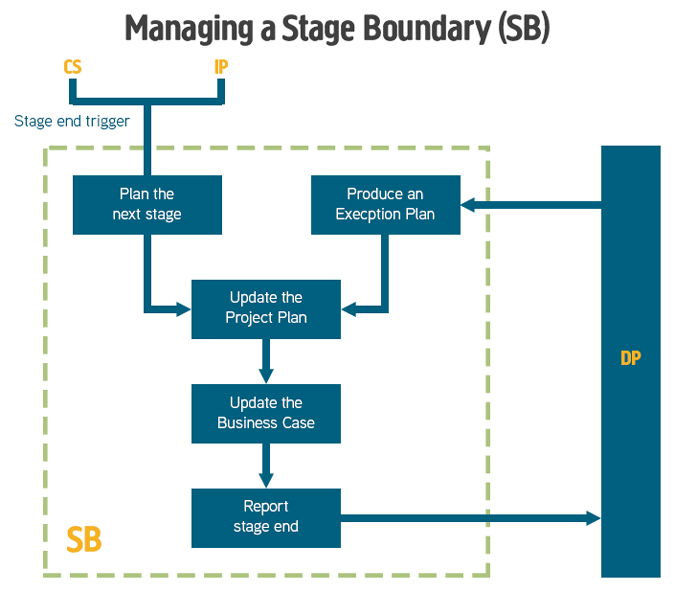
13. Explain Quality Review Team in PRINCE2?
Ans:
The Quality Review Team in the PRINCE2 is responsible for conducting a quality reviews to assess whether the products meet quality criteria. It contributes to product quality by providing the independent assessment and ensuring that products are developed to a required standard.
14. What are two types of progress controls provided by PRINCE2?
Ans:
The two types of the progress controls provided by the PRINCE2 are:
- Time-driven
- Event-driven
15. What is Project Board in PRINCE2, and how differ from Project Manager in terms of decision-making?
Ans:
The Project Board in PRINCE2 is responsible for a making key decisions related to project, including the approving the Business Case, tolerances, and stage plans. The Project Manager is responsible for a day-to-day decision-making within agreed tolerances.
16. How “Focus on Products” influence planning and execution of project in PRINCE2?
Ans:
Focus on Products in PRINCE2 emphasizes for defining and understanding project products early in a project lifecycle. This influences the planning by ensuring that product descriptions, criteria, and quality expectations are the well-defined, guiding execution of project activities.
17. What is Project Product Description in PRINCE2, and how support effective product management?
Ans:
The Project Product Description in the PRINCE2 provides the detailed description of a project’s products, including purpose, composition, quality criteria, and acceptance criteria. It supports an effective product management by serving as the reference for a product development and acceptance.
18. How does PRINCE2 address Stakeholder Engagement, and what play in project success?
Ans:
PRINCE2 addresses the stakeholder engagement through Communication Management Strategy. Stakeholder engagement involves the identifying and communicating with the stakeholders throughout project. Effective engagement is crucial for the understanding and managing stakeholder expectations, which contributes to the project success.
19. Explain Project Assurance in PRINCE2, and how ensures project alignment with organizational standards?
Ans:
Project Assurance in PRINCE2 assesses the overall health and progress of project. It ensures the project alignment with organizational standards by providing the independent assessment and advice, contributing to the quality management and compliance with an organizational processes.
20. What are PRINCE2 deliverables?
Ans:
- Business case
- End of stage report
- Project plan
- Issue Log
- Work package
- Risk management plan
21. During which process is Checkpoint Report generated?
Ans:
Typically, a Checkpoint Report is generated during Managing Product Delivery process. Through establishing of the few formal agreements on the acceptance, implementation, and delivery of project products, this process supervises and controls the work between Project Manager and Team Manager.
22. What is issue register?
Ans:
The revised complaints, issues, difficulties, concerns, and requests that are submitted by the each project participant are noted in issued registers.
23. What is a Business Case?
Ans:
- Revalidates a project
- Kick starts project
- Captures the reasoning for initiating
- Owned by a business
24. What is executive in business case in PRINCE2 project management?
Ans:
The executive in the business case of PRINCE2 project management is responsible for the visualising outputs, outcomes, and benefits and is responsible for the business case.
25. Which document defines acceptance criteria and roles for project?
Ans:
A Project Product Description document defines the acceptance criteria and roles for project. This is created in Starting up the Project process and used during the Closing Project process to help verify that project has been delivered to the expectations.
26. What is business case outline in PRINCE2 project management?
Ans:
The brief business case in the PRINCE2 project management comes from the project mandate, while complete business case comes from the project plan and risk register.
27. What is stakeholder analysis in project, and why is it important?
Ans:
Stakeholder analysis helps a project manager understand stakeholder participation and information demands. Project managers are must comprehend stakeholders who can support, oppose, benefit, lose, threaten or enhance project.
28. What is communication management in project, and what is its purpose?
Ans:
Communication management defines means and frequency of stakeholder communication, enabling the controlled and bidirectional information flow. The project manager must the document and examine a process at stage boundaries and throughout a final planning
29. What is objective of Directing Project process?
Ans:
- To ensure there is authority to be initiate, deliver and close the project.
- To ensure management direction and control are provided throughout project and that project remains viable.
- Plans for the realizing post project benefits are the managed and reviewed
30. What is project assurance team in project, and what are their responsibilities?
Ans:
The project assurance team examines, advises, and monitors the project activities, but they do not make decisions. The project board should only allocate the project assurance duties to project manager if independently monitor project performance and products.
31. What is change authority in project, and how is it determined?
Ans:
The change authority is more responsible for approving or rejecting changes to a project. It may be project manager or individuals with the delegated project assurance responsibilities in the dynamic setting.
32. How to prioritize different tasks?
Ans:
The project manager should be the multitasker who knows how to manage and prioritize multiple tasks that will help achieve task’s completion at a defined budget and time.
- List accountabilities and responsibilities.
- Prioritize between the significant and vigorous
- Assessing every task in a project
- Prioritize responsibilities by assessed efforts
33. What is Procurement Management?
Ans:
It refers to the purchasing the best goods and services at possible beneficial amount to reach all the necessary demands like quality, dimensions, quantity, and site. It requires the planned procurement cycle that includes
- Gathering Information
- Supplier Contact
- Reviewing background
34. What are principles of Prince2?
Ans:
- Manage by stages
- Focus on products
- Manage by the exception
- Tailor to suit project environment
- Continued business justification
- Learn from an experience
- Defined the roles and responsibilities
35. What is Project Tolerance?
Ans:
A project tolerance is the approved (permitted) deviation from a prepared, planned parameters. Usually, it decreases or increases the planned ideas about the project, which includes are:
- Project scope
- Project time
- Project cost.
36. What is use of Prince2 method?
Ans:
The PRINCE2 method is used to the address project management through the four integrated elements of the principles processes, the project environment and themes.
37. Explain Team Forming Procedure for Team?
Ans:
- Forming (focuses on the relationship-building among the team)
- Storming (concentrates on the understanding opinions among the team)
- Norming (Get clarity on point to reach next stage)
- Performing (built trust in a team to perform well in provided tasks)
- Adjourning (end process to release the team member’s role)
38. How to handle challenging client involved in the project?
Ans:
Since stakeholder or client holds final passing and the authority of every stage in a project, it is important that client passes all the stages and approves the completion procedure. To deal with the challenging and unmanageable client, project manager can
- Take stakeholder’s consent without the argument.
- Remove pre-assumptions and all negative thoughts about client.
- Take advice and listen to them.
- Use the communication and convincing skills.
- Understand the client’s requirement and issues precisely
39. What are common communication blockers?
Ans:
- Accusing
- Judging
- Diagnosis
- Globalizing
- Interrupting
- Insulting
- Sarcasm
40. What is business case?
Ans:
- Revalidates the project
- Kick start the project.
- Owned by the business
41. What are types of project?
Ans:
- Compulsory
- Not for profit
- External Project
- Evolving Requirements
- Multi organization project
42. What are activities in CP process?
Ans:
- Prepare a planned closure
- Prepare a premature closure
- Handover products
- Evaluate the projects
- Recommended the project closure
43. What are prince2 deliverables?
Ans:
The prince2 deliverables are :
- Business case
- End of stage report
- Project plan
- Issue Log
- Work package
- Risk management plan
44. What are planning approaches?
Ans:
The planning approaches are:
- Work based Planning
- Deliverable / Product planning.
45. What are activities in DP process?
Ans:
- Authorize the project closure
- Authorize stage or Exception plan
- Authorize Initiation
- Give ad – hoc support
- Authorize project
46. What are activities in SU process?
Ans:
- Appoint executive and project manager
- Prepare the business case outline
- Select a project approach
- Plan Initiation stage
47. What are risk strategies?
Ans:
- Risk tolerance
- Risk Appetite
- Ongoing Activity
- Avoid, Seek, Neutral
48. How to achieve team agreement for results as project manager?
Ans:
- Keep clear prospects from initial stage.
- Build the attainable milestones for the team
- Reach agreements with the team’s opinion
- keep team trust and work together throughout the project
- Schedule the regular meetings
- Conflict a management in team
49. What is idea behind product delivery process?
Ans:
The main idea or purpose behind Managing Product Delivery process is to build and control the strong link between the team manager and project manager to manage the three important stage plans.
- Accepting and checking a work packages
- Ensuring and executing a work packages
- Delivering work packages
50. How many products are defined in PRINCE2?
Ans:
- Benefits Review Plan
- Work Package
- Business Case
- Risk Register
- Checkpoint Report
- Risk Management Strategy
- Communication Management Strategy
- Quality Register
- Configuration Item Record
51. Define ‘Plan’ in PRINCE2methodology?
Ans:
A plan is basically the timeline that provides us with the vision of how the objectives can be achieved and point out main products, activities, and resources that are required for a scope of the plan.
52. Who are primary stakeholders of Prince2 project?
Ans:
- Users
- Suppliers
- Business sponsors
53. Explain quality planning and quality control?
Ans:
Quality planning in the PRINCE2methodology the process of identifying the quality requirements of the project such as deciding on what attributes are required to make product fit for the purpose and plan on how to achieve that product. On other hand, quality control is a process of executing the plan and conduct the quality tests to ensure that product meets an expected requirements.
54. Which department(s) is responsible for establishing project tolerance in PRINCE2® methodology?
Ans:
- Project Support
- Project Board
- Project Management
- Customer Support,
55. What are various deliverables offered by PRINCE2®?
Ans:
- Business case
- End of stage report
- Project plan
- Issue Log
- Work package
- Risk management plan
56. Why project is split into number of stages?
Ans:
By splitting up the project into the multiple stages helps the Project Managers to breakdown entire project activities into manageable chunks. This provides a better control and execution over project. Also, with splitting the project into the stages, similar kind of work can be grouped together and funds and resources can be allocated better to the each stage. It will, in turn, increase efficiency and reduce the unnecessary wastage of the money as well as resources. Also, with this approach responding to a customer need becomes more easier and enhances agility of the projects.
57. which process of PRINCE2 based project, Checkpoint Report is produced?
Ans:
During Managing Product Delivery process, Checkpoint Report is generally produced. This process is the responsible for managing and controlling the work among the Project Manager and Team Manager by setting the few formal agreements on acceptance, execution, and delivery of project products.
58. What is configuration management PRINCE2 methodology?
Ans:
Configuration management in the PRINCE2 is the technical and administrative activity that mainly focuses on the creating, maintaining and controlling the change of configuration throughout complete lifecycle of a final product. A configuration item is nothing but main entity which is subjected to the configuration management. This entity can simple component of a product or the set of products which are to be released to a customer.
59. List few risk strategies implemented in PRINCE2 projects?
Ans:
- Risk Tolerance
- Risk Appetite
- Ongoing Activity
- Avoid, Seek, Neutral
60. Difference between project and business-as-usual operation?
Ans:
| Aspect | Project | Business-as-Usual (BAU) | |
| Definition |
A temporary endeavor with a specific goal, tasks, and timeline. |
Ongoing, routine activities sustaining normal organizational operations. | |
| Duration | Finite and temporary, with a defined beginning and end. | Continuous, without a predefined endpoint. | |
| Objective | Aims to achieve a unique and specific outcome or deliverable. | Ongoing tasks to maintain and support normal organizational operations. |
61. Explain Risk Register in PRINCE2?
Ans:
The Risk Register in the PRINCE2 is used to identify, assess, and manage project risks. It includes the details such as the nature of the risk, its impact, likelihood, and planned responses to be mitigate or address the risks.
62. What is Change Control Approach in PRINCE2?
Ans:
The Change Control Approach in PRINCE2 outlines procedures for handling the changes to the project baseline. It defines how changes are to identified, assessed, authorized, and implemented to be ensure they do not adversely affect project’s objectives.
63. How does PRINCE2 address concept of quality in project management?
Ans:
PRINCE2 emphasizes quality through Focus on Products principle. It requires the defining quality criteria for a products and ensuring that they are met throughout the project. Quality is also monitored through the regular quality reviews and audits.
64. Explain Managing by Stages in PRINCE2?
Ans:
Managing by Stages involves the breaking the project into manageable stages, each with its own objectives, plans, and controls. It allows for a better control and decision-making by reviewing and approving project at the end of each stage.
65. What is Project Initiation Document (PID) in PRINCE2?
Ans:
The Project Initiation Document (PID) is the key document in PRINCE2 that provides the comprehensive understanding of project. It includes project’s objectives, scope, organization, approach, and overall plan. The PID is used as the reference throughout project lifecycle.
66. How does PRINCE2 handle concept of tailoring, and why is it important?
Ans:
Tailoring in PRINCE2 involves the adapting the methodology to suit specific needs and characteristics of the project. It is important to ensure that the project management approach is an appropriate and proportionate to project’s size, complexity, and risk.
67. What is Project Board in PRINCE2, and who are its key members?
Ans:
The Project Board is responsible for overall direction and decision-making of a project. Key members include the Executive , Senior User (represents end users), and Senior Supplier (represents those delivering products).
68. Explain Lessons Learned in PRINCE2?
Ans:
Lessons Learned are the insights gained from project experiences that can be applied to the future projects. PRINCE2 encourages the regular review of Lessons Learned, which are captured in End Stage Report and End Project Report. They are used to improve the future project performance.
69. How does PRINCE2 support concept of “Focus on Products”?
Ans:
Focus on Products is a PRINCE2 principle that emphasizes importance of clearly defining and understanding a products (deliverables) of the project. This involves creating Product Descriptions, Product Breakdown Structures, and Product Flow Diagrams to guide the product development and acceptance.
70. Difference between Project Assurance and Project Support roles in PRINCE2?
Ans:
Project Assurance is responsible for the assessing and providing confidence that project is being conducted effectively. Project Support provides an administrative support to a project manager and assists in maintaining a project controls and documentation.
71. What is Communication Management Strategy in PRINCE2?
Ans:
The Communication Management Strategy in the PRINCE2 outlines how communication will be handled within project. It identifies key stakeholders, defines the communication methods, and ensures that information is distributed appropriately to keep the stakeholders informed.
72. Explain Product Description in PRINCE2, and how used in project management?
Ans:
The Product Description defines characteristics, purpose, and quality criteria of the product. It is used to ensure the common understanding among project stakeholders about what needs to delivered. The Product Description becomes the reference point for the product development and acceptance criteria.
73. Explain Change Theme in PRINCE2?
Ans:
The Change Theme in PRINCE2 addresses need to control and manage changes to a project baseline. It includes processes for the identifying, assessing, and handling requests for the changes, ensuring that are properly authorized and implemented.
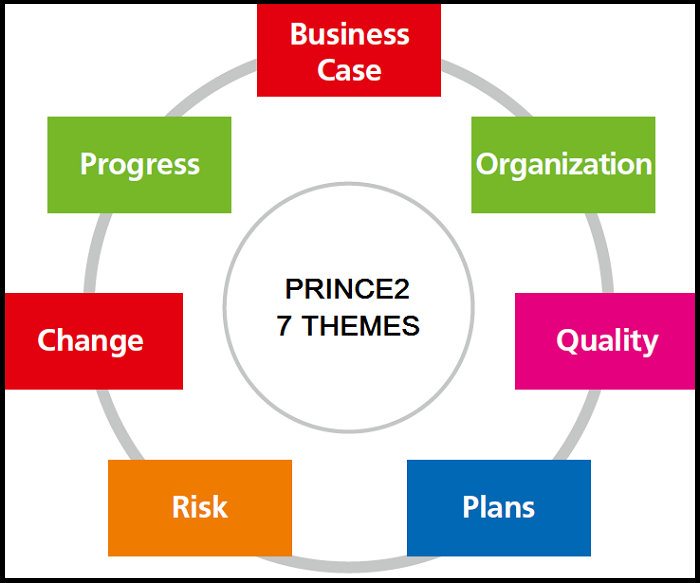
74. How does PRINCE2 handle concept of quality management throughout project lifecycle?
Ans:
PRINCE2 integrates the quality management throughout the project by defining a quality criteria for each product, establishing the quality responsibilities, and conducting a regular quality reviews. Quality is monitored through project’s life, from initiation to closure.
75. What is Lessons Log in PRINCE2, and how is used in project management?
Ans:
The Lessons Log is used to capture the insights and experiences gained during the project. It includes both the positive and negative lessons and is updated throughout a project lifecycle. The Lessons Log serves as the valuable reference for improving the future project performance.
76. How does PRINCE2 address need for effective risk management in projects?
Ans:
PRINCE2 includes the dedicated theme for Risk Management. It involves the identifying, assessing, and managing risks throughout a project lifecycle. The Risk Register is used to the document and monitor risks, and risk management is embedded in the other processes and themes.
77. Explain Project Mandate in PRINCE2, and when is it created?
Ans:
The Project Mandate is created during Starting Up a Project process and provides the initial project idea, including the business reasons for project. It is used to decide whether to initiate project and create Project Initiation Document (PID).
78. Difference between Product Description and Product Flow Diagram in PRINCE2?
Ans:
A Product Description provides the detailed information about a specific product, including purpose, composition, quality criteria, and acceptance criteria. A Product Flow Diagram, on other hand, visually represents a sequence and interactions of the products within a project.
79. Explain Change Authority in PRINCE2, and how is it appointed?
Ans:
The Change Authority is responsible for a making decisions regarding requests for the change. It is appointed by a Project Board and could include the members of the Project Board or the other individuals with an appropriate authority and knowledge.
80. How does PRINCE2 handle “Tolerances” and why are they important?
Ans:
Tolerances in the PRINCE2 define the permissible deviations from the project plan and the other baseline elements. They provide flexibility for a Project Manager to manage within the acceptable limits without requiring constant approval from a Project Board.
81. Explain Business Change Manager in a PRINCE2 project.
Ans:
The Business Change Manager is responsible for the ensuring that desired benefits of the project are realized during and after project. They represent the interests of end-users and stakeholders, ensuring that project aligns with the business objectives.
82. How does PRINCE2 handle concept of risk escalation?
Ans:
PRINCE2 promotes the escalation of risks to be higher levels of management when they cannot be effectively managed at a project level. This ensures that risks are more appropriately addressed, and decisions are made at appropriate organizational level.
83. What is Checkpoint Report in PRINCE2, and when is it produced?
Ans:
The Checkpoint Report is produced by a Team Manager to inform the Project Manager of status of work packages. It includes an information on work package progress, issues encountered, and forecasted completion. Checkpoint Reports are help in monitoring and controlling the project progress.
84. What is Daily Log in PRINCE2, and who is responsible for maintaining it?
Ans:
The Daily Log in the PRINCE2 is maintained by a Project Manager and serves as the diary of events and actions on a day-to-day basis. It captures the issues, risks, and other noteworthy information, providing the record of project activities.
85. What is End Project Report in PRINCE2, and when is it created?
Ans:
The End Project Report is created during the Closing Project process. It provides the comprehensive overview of project’s performance, including achievements, deviations from a plan, and lessons learned. The report is used for the project evaluation and as reference for a future projects.
86. Explain Project Manager during “Managing a Stage Boundary” (SB) process in PRINCE2?
Ans:
During the Managing a Stage Boundary process, the Project Manager prepares for a next stage by updating the Project Plan, Business Case, and Risk Register. They also create the Exception Plan if necessary. The Project Manager seeks approval from Project Board to proceed with the next stage.
87. Explain “Agile” in PRINCE2 Agile?
Ans:
PRINCE2 Agile is the extension of PRINCE2 that incorporates the agile methodologies. It allows an organizations to blend the governance and control aspects of PRINCE2 with flexibility and responsiveness of the agile practices. “Agile” in this context refers to iterative and collaborative approach to the project delivery.
88. Explain Benefits Review Plan in PRINCE2, and when is it created?
Ans:
The Benefits Review Plan is created during Initiating a Project process. It outlines how and when an expected benefits of project will be realized, measured, and reviewed. The plan ensures the focus on achieving a desired outcomes and benefits.
89. What is Project Assurance in PRINCE2, and how does it contribute to project success?
Ans:
Project Assurance in the PRINCE2 ensures that the project is conducted effectively and aligns with the organizational standards. It provides the independent assessment and advice, contributing to the project success by maintaining the focus on quality and compliance.
90. How does PRINCE2 handle concept of project tolerance, and why is it important?
Ans:
Tolerance in PRINCE2 defines the permissible deviations from a project plan and other baseline elements. It is important because it provides the flexibility for the Project Manager to manage within the acceptable limits without constant approval, allowing for an efficient decision-making.
91. What is Initiating a Project process in PRINCE2?
Ans:
The Initiating a Project process sets a foundation for the project. Key documents created include Project Brief, Project Initiation Document (PID), and the Communication Management Strategy. This process establishes project’s viability and alignment with the business goals.


